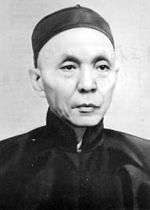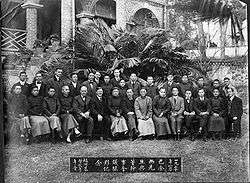Wong Nai Siong
Wong Nai Siong (Chinese: 黄乃裳) (1849—1924) as a Chinese revolutionary leader and educator from Minqing county in Fuzhou, Fujian province, China. He served in The Methodist Episcopal Church for many years and participated in the "Letter to Bus" reform, Hundred Days' Reform and also the Xinhai Revolution which resulted in the formation of Republic of China. He also led people from Fujian province to migrate to other countries including Malaysia, especially Sibu, Sarawak.
Wong Nai Song | |
|---|---|
 | |
| Personal details | |
| Political party | Chinese Alliance Party |
| Spouse(s) | [First wife - Mdm Xie] [Second Wife - Mdm Qian] |
Early life, conversion and education
Wong Nai Siong was born in Fuzhou Ming Qing, where his father was a carpenter.[1] He did farm work to help provide for his family, studying at the same time. In 1866, missionaries from the Methodist Episcopal came; Wong Nai Song was baptised and converted to Christianity in November that year. The villagers disapproved, but didn't ostracise him, as they were from the same clan. As time went by, many villagers also converted to Christianity.
In the winter of 1867, priest Xu Yang Mei took Wong Nai Siong as an assistant and taught him the Bible. This led to Wong Nai Siong's learning English and being exposed to Western culture and thinking. When asked his reason for converting to Christianity, Wong Nai Siong remarked on the disparity between the teachings of Confucius and the actions of those who professed Confucianism.
Imperial Examination
During his missionary time, Wong Nai Siong noted that few Christians among the influential people in the area, so he decided to take part in the Imperial Examination. In 1877, he became a scholar. His father died in 1884. In 1894, Wong Nai Siong graduated with a 30th position in the Imperial Examination.
Hundred Days reform
In 1894, Wong Nai Siong's third brother was killed in the First Sino-Japanese War. Believing that government incompetence and corruption had led to the downfall of his country, he met Kang You Wei in Beijing and took part in the "Letter to Bus" reform. In 1896, he started the first Christian newspaper which promoted political reform. In 1897, he once again sat for the Imperial Exam. He submitted eight petitions for reform. Following the failure of the reform movement, he was pursued by the Qing government, forcing him to flee back to Fujian.

Reconnaissance for resettlement
In September 1899, Wong Nai Siong came to Singapore and worked as an editor for a local newspaper. During his stint, knowing that life was difficult for the people of Fujian, he went to Malaysia, Sumatra and the Dutch East Indies to search locations for immigrant resettlement and escape from Empress CiXi's authoritarian rule.
In April 1900, at the recommendation of his son-in-law, he investigated Sarawak's Rejang River Basin. In this area with a small population and large amount of undeveloped land, immigrants were welcomed. In late May 1900, Wong Nai Siong, acting as the harbour master, signed a resettlement contract with the Sultan for the Rejang Riverbanks area.
Resettlement at Sibu
In September 1900, Wong Nai Siong and his party started recruiting villagers to immigrate to Sibu; they were able to recruit over 500. On 23 December 1900, the first batch of 91 immigrants left for Sibu, arriving on 12 January 1901. Some of the prospective immigrants changed their minds during the journey, so only 72 people reached Sibu.
The second batch of immigrants was led by Wong Nai Song personally from Fujian.[2] However, during their stop in Singapore, rumours of the villagers being sold as coolies resulted in a riot. Wong Nai Siong, with the help of the priest from the Methodist Episcopal Church, was able to stop the rioting. On 5 March 1901, the immigrants left Singapore; they reached Sibu eleven days later.[3]
The third batch of immigrants totalled 1118, of whom two-thirds were Christians. They reached Sibu on 7 June 1902.
Wong Nai Siong renamed Sibu as New Fu Zhou. He took out a loan of to build six atap houses in New Zhushan to accommodate the farmers.[4] Later, he changed the name of New Zhushan to New Cuo Ann, reflecting the prosperity of the new settlement.
Wong Nai Siong gave each farmer 5 acres (2.0 ha) of land for farming. However, the new immigrants were not accustomed to the local climate and many fell ill. On top of that, they had to explore new techniques of farming, which made their life more difficult.
Wong Nai Siong established the New Fuzhou Company, which sold basic necessities, including rice and salt, to the immigrants. He built five churches and a primary school during his stint in Sibu.
During a lion dance event on the Yuan Xiao of 1930 (15 January of the Lunar Calendar), there was a gang fight between the FuZhou immigrants and the immigrants from Guangdong. This had to be settled by Wong Nai Siong and the Guangdong immigrant leader. To prevent future conflicts, the Sultan directed immigrants from FuZhou to develop the area below Rejang Sibu.
In June 1904, Wong Nai Siong passed the managing duties to American priest James Hoover, and returned to Fujian. There were many rumours regarding his departure, including poor health, his yearning for revolutionary work, huge debt and his reluctance to deal opium. After this departure, Hoover introduced rubber-tree planting; the boom in latex propelled Sibu's economy.
Return to China
In June 1906, Wong Nai Siong met Sun Yat-sen in Singapore and joined the Chinese Revolutionary Alliance. He started disseminating revolutionary propaganda in China, and was involved in the planning of the Chaozhou Huanggang Uprising and the promoting of Fuzhou's education and industrialisation.
Constitution revolution
In 1909, the government began promoting the establishment of a constitution. Wong Nai Siong was elected as a committee member for the Fujian Province. During his term, he submitted several detailed proposals regarding such matters as the establishment of a coastal police, the promotion of farming and industrialisation, and the prohibition of the sale of opium. In 1910, he became the chairman of the Fuzhou YMCA.
Resignation
In 1912, Wong Nai Siog quit his position due to poor health, although rumours suggested that it was due to his support for the prosecution of Pengshou Song, Secretary of the Fujian Provincial Government Administration Council (Hunan). In 1914, Yuan Shi Kai framed Wong Nai Song for obstructing the "smoke ban" campaign, and he was sentenced to life imprisonment. Upon pressures from abroad, he was released a few months later.
Later years


In 1920, Wong Nai Siong was appointed the higher consultant in the Marshal Office by Sun Yat Sen. In 1921, while on leave in Fujian, he was also appointed a senior consultant in the Fujian Province Office.
In July 1923, he returned to Minqing County due to liver illness. He died on 22 September 1924.
After death
In China
On 13 May 1947, Fujian Province changed the name of Wang Hou Street to Nai Siong Road, to commemorate Wong Nai Siong's lectures in the Ming Qing Hall located on the street. The road was renamed as Shu Xin Road during the Cultural Revolution, but the name was later changed back to Nai Siong Road.
In December 1979, Ming Qing County of Fujian built a memorial museum at the Ban Tou River. A statue of Wong Nai Siong was erected the following year.
In 1995, the Ming Qing Ban Dong Town Lake Street was renamed "Nai Siong Street", and the Wong Nai Siong memorial museum in Ming Qing Tai Shan Park was completed.
In 1991, the graves of Wong Nai Siong and his brother Wong Nai Mo were declared provincial cultural relics. In 2001, they became a base for patriotism education.
Overseas
In 1958, Malaysia Sibu Municipal named one of the street to Nai Siong Road. On 16 March 1961, Sibu celebrated 60th year of resettlement and unveiled the statue of Wong Nai Siong. In 1967, the "Wong Nai Siong Secondary School" was established. On 16 March 2001, Wong Nai Siong Park and Wong Nai Siong Monument were opened to the public. On 23 November 2007, during the twentieth anniversary of Hong Kong's Asia Week, Taiwanese author and Taiwan's minister of culture Lung Ying-tai mentioned Wong Nai Siong's accomplishments and expressed her disappointment that not many people know of Wong Nai Siong. On 24 November 2012, during a seminar on "Wong Nai Siong and the Fujian Spirit", participants from both China and Taiwan suggested shooting a feature film on Wong Nai Siong. Wong Nai Siong's great granddaughter Wong Bi Yao (Anne Pang) revealed that she would be meeting Lung Ying_tai in late 2012 to discuss Lung's suggestion.
References
- Lee Khoon Choy (26 March 2013). Golden Dragon And Purple Phoenix: The Chinese And Their Multi-ethnic Descendants In Southeast Asia. World Scientific. p. 462. ISBN 978-981-4518-49-9.
- Patricia Pui Huen Lim; Chong Guan Kwa; James H. Morrison (1998). Oral History in Southeast Asia: Theory and Method. Institute of Southeast Asian Studies. p. 127. ISBN 978-981-230-027-0.
- David W. Scott (26 July 2016). Mission as Globalization: Methodists in Southeast Asia at the Turn of the Twentieth Century. Lexington Books. p. 167. ISBN 978-1-4985-2664-7.
- Pat Foh Chang (1999). Legends & History of Sarawak. Chang Pat Foh. pp. 212–213. ISBN 978-983-9475-06-7.
External links
- - http://www.66163.com/Fujian_w/news/huabao/hb0106/c-h6-3.html
- - http://blog.sina.com.cn/s/blog_4f9fbc8d010083f9.html
- - http://www.dajunzk.com/longyanj.htm
- - http://www.chinanews.com/tw/2012/11-24/4355304.shtml
- - http://ent.china.com.cn/live/2012-11/24/content_17323899.htm
- - http://taiwan.huanqiu.com/roll/2012-11/3309517.html